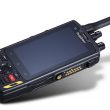News Briefs – Wednesday, June 19, 2006
Childcare centers chose AT&T for wireless service
AT&T secured an additional $1.3 million network integration project from the Learning Care Group, which is the parent company of Childtime and Tutor Time Learning Centers that provide child-care and preschool educational services. The company will provide each Learning Care Group center throughout the United States with equipment and networking integration packages for wireless broadband connectivity. Staff will be able to use portable computers from anywhere within each facility to view information and update each child’s progress while accessing centralized data and business applications, according to AT&T.
Medical software transfers images to physicians’ hand-helds
Healthcare software developer Global Care Quest released the Integrated Clinical Information System PocketPACS, a viewing application able to wirelessly send images to a physician’s hand-held device or mobile smartphone. The images are obtained from a picture archiving and communication system (PACS) comprised of hardware and software for the digital communication, archiving, processing and viewing of images and image-related information, or from a digital imaging communications in medicine (DICOM) system, a standard method used to allow interoperability and interconnection between medical imaging devices. PocketPACS displays chest X-rays, bone X-rays, CT scans, MRI scans and other medical imaging modalities, according to the company.
Smartphone software supports Wi-Fi radio
Symbian unveiled version 9.3 of its operating system for smartphones with native support for USB 2.0 connections and next-generation HSDPA wireless technology. The new version adds support for Wi-Fi radio and lets users switch the phone between cellular and Wi-Fi networks using VoIP technology. According to the company, the software also was developed to meet the demands of operators and manufactures wanting to remove features on lower-priced models or add features to high-end models.
JFW Industries launches test device
JFW Industries launched its 50T-453 RF load, designed for intermodulation testing and measurements at 165 dBc at 1950 MHz (with two 20-watt tones). It has a 50-watt input power rating and a VSWR[0] of 1.20:1 maximum at 3000 MHz, according to the company. It is available with 7/16 or N connectors.
GPS receiver deployed by Chicago and New York fire departments
u-blox America announced its Antaris GPS receiver will be incorporated into Motorola’s MDR800 model F5127 vehicle tracking system deployed by the Chicago and New York fire departments. According to u-blox, the receiver delivers location information even if the targeted vehicle is situated in a tunnel or underground parking garage.
New adaptive mesh connectivity engine
Tropos Networks’ new Adaptive Mesh Connectivity Engine is a mesh software solution that runs on the company’s MetroMesh routers to compensate for the variations in Wi-Fi devices that use metro-scale mesh networks. The engine uses per-packet transmission power and timing control to compensate for low-power client devices so users can choose the router that offers the best connection to the Wi-Fi network and the data rate that should be used for the connection, according to the company.
Command centers styled in SUV fashion
L-3 Communications’ Wolf Coach subsidiary has been awarded a contract to provide 19 MC2 SUV-based mobile command centers and two large Sentinel custom body-on-chassis mobile communication centers to support a wide range of homeland security requirements for the Department of Defense (DoD). The systems establish data connectivity using satellite access and provide telephony through VoIP. In addition, the command centers facilitate interoperable communications between various governmental, law enforcement, rescue/recovery and disaster relief agencies. Incident commanders coordinating emergencies will use the vehicles to establish a base of operation to coordinate information and personnel, according to L-3.












